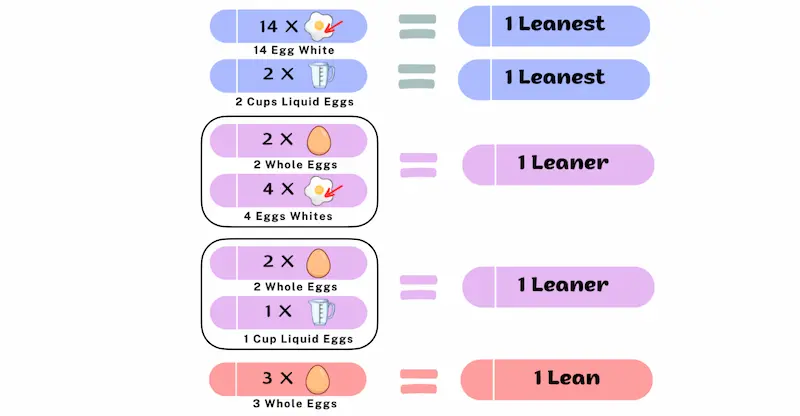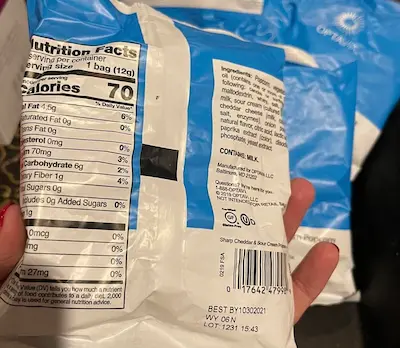Eggs are a popular breakfast option for many people, but if you’re following the Optavia diet, you may be wondering if they’re allowed.
The answer is yes, but it’s important to understand how eggs fit into the overall plan.
In this article, we’ll discuss how eggs can be incorporated into the Optavia Lean and Green menu, as well as how many eggs you can have to count as a Fueling.

First, let’s talk about eggs and weight loss
In our home, we love eggs. (In all shapes and forms).
Whenever I was doing the Optavia diet, Ketogenic diet, or any other weight loss program, eggs were always on top of our diet food checklist.
Here’s a photo of my fridge after doing the weekly shopping.

Full of meat, veggies, and eggs.
Eggs are not only incredibly versatile but also high in proteins (which helps me feel full and satisfied).
According to the randomized controlled trial published in the International Journal of Obesity, “the egg breakfast enhances weight loss when combined with an energy-deficit diet.”
This means that if you want to lose weight, eating eggs can help. But if you don’t reduce your overall food intake, eating eggs won’t make any difference.
What do eggs count as on Optavia?
Eggs are an excellent protein source on Optavia, especially for those following a meatless meal plan.
According to Optavia guidelines, you can have 14 egg whites as one of your leanest protein options.
Additionally, you can have 2 cups of liquid egg substitute or liquid egg whites, which also count as your one LEAN serving.
When it comes to whole eggs, they also can also be consumed, but they are considered LEANER and LEAN options due to their higher fat content.
According to the U.S. Department of Agriculture, one medium size egg contains 71 calories, 6 grams of protein, and 5 grams of fat.
So yes, eggs can be a good source of protein, but keep in mind that they are also high in fat. So, if you’re watching your fat intake, you might want to stick to egg whites.
Optavia egg beaters
What about egg beaters?
The graph below helps to understand how to use (and measure) egg beaters on Optavia.

How many eggs can I have on Optavia?
Here you have easy to follow graph that explains how many eggs can you have on Optavia.

According to Optavia guidelines, you can have 2 whole eggs and 4 egg whites per meal as your lean options.
That is your one serving and it equals 20 grams of proteins and 170 caloires (1).
You can also use 3 whole eggs as your main protein, but you should limit your intake to twice per week.
One of the main reasons for this restriction is that whole eggs have more calories than egg whites.
The table below shows you the comparison between one whole egg and one egg white when it comes to nutritional value.
| Whole egg | Egg white |
|---|---|
| 71.5 kcal | 17.2 kcal |
| 6.2 g of protein | 3.53 g of protein |
| 4.98 g of fat | 0 g of fat |
| 24 mg of calcium | 2.31 mg of calcium |
| 5.5 mg of magnesium | 3.63 mg of magnesium |
| 66 mg of potassium | 53.8 mg of potassium |
Although removing the yolk from the egg shaves off around 50 calories and 5 grams of fat, it also reduces the proteins and calcium.
(I still think it’s okay to have more than one serving of eggs.)
For me, I often have 4-6 whole eggs in my lean and green meals, despite them having more fat.
I hate eating egg whites without the yolk. And even if eating whole eggs means more calories, I still do it.
However, if you’re a beginner who just go started with the Optavia plan, I recommend following their guidelines to the letter and eating just egg whites.
Do eggs count as a Fueling on Optavia?
The table below compares the nutritional value between Optavia Fuelingsa and whole eggs.
| Whole egg | Optavia Fueling |
|---|---|
| 71.5 kcal | 110 kcal |
| 6.2 g of protein | 11 g of protein |
| 4.98 g of fat | 3 g of fat |
| 24 mg of calcium | 196 mg of calcium |
| 66 mg of potassium | 318 mg of potassium |
As you can see, the Optavia fuelings have completely different macro and micronutrients than eggs.
Fuelings have more calories, but they also have more balanced proteins, carbs, and fats. They are also fortified with vitamins and minerals.
And while Optavia Fuelings do not have the same nutritional value as eggs, they can be included in the program.
(This is where the fun begins.)
Although I eat eggs for my main lean and green meal, I also use them as my homemade fueling alternatives.
The key is to combine them with other foods to match the Fueling macronutrients.
Each Fueling has around 110 caloires, 11 grams of protein, and less than 15 grams of carbs.
So to mimic this nutritional value, you need to add something else to eggs to meet these requirements.
Here’s the photo of one of my favorite homemade Fueling substitutes.

This one is made from 1 poached egg, 5 thin slices of avocado, and 14 spears of asparagus. I also like to use scrambled eggs.
The table below shows you a few more examples of how eggs can be used as a replacement for Fuelings.
| Fueling alternative | Calories | Protein |
|---|---|---|
| 1 whole egg 2 oz cottage cheese | 120 | 12 |
| 1 whole egg 1 oz avocado | 115 | 7 |
| 1 whole egg 2 oz baked beans | 125 | 10 |
| 1 whole egg 1 link Hillshire Farm beef smoked sausage | 110 | 10 |
| 1 whole egg 3 oz green peas | 130 | 11 |
As you can see, you can make Fuelings out of eggs when you combine them with other low-calorie food items that are high in proteins (ideally).
Do eggs count as a snack on Optavia?
When it comes to snacks, one whole egg can be counted as an Optavia snack becasue it has very similar nutritional value.
Here’s the photo of the Optavia Olive Oil and Sea Salt Popcorn.

The nutritional label shows this snack has 70 calories, 6 grams of carbs, and 1 gram of proteins.
Here is the comparison between one whole egg and one Optavia snack.
| Whole egg | Optavia snack |
|---|---|
| 71.5 kcal | 70 kcal |
| 6.2 g of protein | 1 g of protein |
| 4.98 g of fat | 4.5 g of fat |
| 24 mg of calcium | 3 mg of calcium |
| 66 mg of potassium | 0 mg of potassium |
As you can see, compared to Optavia snacks, whole eggs have much better macronutrient value across the board.
Sure, they have 0.5 grams of fat more than snacks.
But at the same time, they have five times more proteins and nine times more calcium than snacks.
What types of eggs can be consumed on Optavia?
Although boiled and poached eggs have the least amount of calories, there are other egg variations you can have on Optavia.
- Scrambled eggs
- Fried eggs
- Omelets
- Quiches
- Frittatas
- Egg salads
- Egg whites
- Liquid egg whites
- Liquid egg substitute
The only thing I would keep in mind is how you prepare your eggs.
Deep frying eggs in oil will significantly increase overall calories count versus poaching eggs in the microwave.
How to incorporate eggs into the Optavia diet plan
Incorporating eggs into the Optavia meal plan can be a great way to get an extra boost of protein and flavor.
However, please remember that eggs are also high in calories, so it’s important to consider the calorie content of egg dishes when preparing breakfast, lunch, or dinner.
Here are some tips for reducing the calorie count of Lean and Green meals without compromising on taste:
- Choose egg whites as they contain fewer calories than whole eggs.
- Use low-fat milk or non-dairy milk instead of cream when making scrambled eggs or omelets.
- Use cooking spray or a small amount of oil, instead of butter or margarine.
- Use liquid egg substitutes, such as Egg Beaters, which have fewer calories than whole eggs.
- Avoid adding cheese and other high-fat toppings. Instead, use salsa, hot sauce, or mustard.
- Use low-calorie cooking techniques like poaching or boiling rather than frying.
The bottom line
Overall, incorporating eggs into my Optavia diet has been a game-changer for me and I highly recommend it to anyone looking to lose weight.
However, it’s important to remember that the way you prepare eggs can affect their calorie content.
That’s why I recommend you stick to Optavia guidelines when it comes to egg consumption, which is 2 whole eggs and 4 egg whites per meal as my lean options.
Also, make sure to consult with a healthcare professional or a registered dietitian before making any changes to your diet.
References
U.S. Department of Agriculture, Agricultural Research Service. FoodData Central, 2019. fdc.nal.usda.gov.
